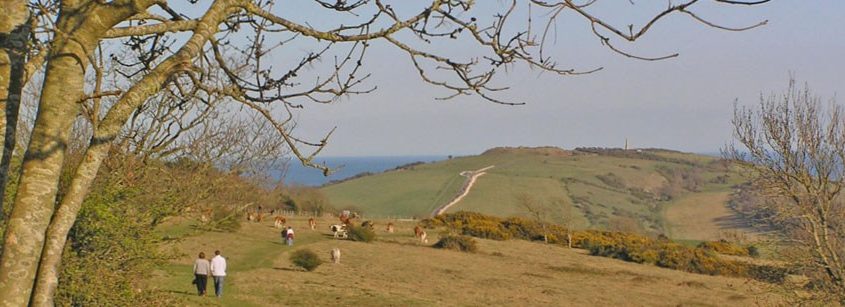
Brading Down
Brading Down is one of the Island’s most popular sites for recreation, picnicking and wildlife watching, offering stunning panoramic views, a wealth of habitats to explore and opportunities for everyone to enjoy the countryside. It lies at the eastern end of the Island’s iconic central chalk ridge and is within the Isle of Wight Area of Outstanding Natural Beauty. Brading Down Local Nature Reserve extends both sides of the main road, and the views are equally stunning. Visit the down land on this reserve for chalkland flowers, butterflies and birds of prey.
Brading Down Local Nature Reserve is one of the Island’s most popular sites for recreation picnicking and wildlife watching. The beautiful viewpoint has some of the best panoramic views on the Island, stretching from the Eastern Solent right across to Ventnor Downs.
There are four distinct areas to visit; Nunwell Down and Little Jane’s Quarry, Brading Down, Bulley’s Pit and Munns Pit. The areas north of Brading Down Road are Nunwell Down and Little Jane Quarry. There is chalk grassland, great views of Brading, Bembridge and the Solent and gently sloping downland eventually dipping steeply to Little Jane Quarry, which is a woodland area with lovely shaded walks. Brading Down is the main part of the site and is accessed directly from the car parks. It is mainly open chalk downland and is sometimes grazed by cattle. There are several seats and picnic tables and super views of the south of the Island. It is one of the Island’s best kite flying spots.Bulley’s Pit can be accessed from Brading Down and is a wonderful place to go on a butterfly as they like the warm chalk walls. It also has a barbecue and community stage. Munns Pit is accessed from Upper Alverstone Road. It’s a very peaceful but steeply sided quarry and has wonderful flora.
What to look and listen for …
Look out for drifts of primroses and dog violets in early spring. The thin chalk soils to the east of the site support a typical downland plant community with pyramidal orchids being a particular feature in the summer. In recent years a programme of scrub clearance has been undertaken. The area is good for butterflies including common blue, chalkhill blue, small, large and dingy skippers, marbled white, gatekeeper, and meadow brown. Those lovely people at the Isle of Wight Natural History and Archaeology Society did a bug survey for us and you can see what they found here. In addition to the wildlife interest of chalk downland, the ancient field system on Brading Down is a Scheduled Ancient Monument. The finest surviving ancient field system on the Island is to be found on the down. This is likely to be of late Iron Age or Roman date and highlights the last time the fields were ploughed. The views over Bembridge Harbour, the Solent, Brading Roman Villa , The Eastern Yar River and the English Channel reinforce the historical significance of the area.
The buzzards mew overhead, and other birdsong includes that of robins, great tits, goldfinches and blackbirds. The linnet was once very popular as a cage bird because of its melodious song. It has an undulating flight, usually twittering as it flies, but its sound can be drowned out by the noisy gulls from Sandown Bay. Brush through the meadows at the height of summer and you’ll hear the tiny seeds of yellow-rattle rattling in their brown pods, hence its name.
… and smell and touch
In spring the gorse has a coconutty whiff, and in summer, the ‘frothy’ flowers of lady’s bedstraw can carpet the grasses of the meadows with yellow and fill the air with a sweet, honey-like scent. There’s stinking iris in Bullys Pit. Sniff it and you will realise why it got its name.
This is great space for kite flying. Why not take a picnic with you? Have a song and dance on our community stage in Bulley’s Quarry, and you can chat with the man by the barbecue in Bully’s Quarry – please feel free to use the barbecue but take home all rubbish. In autumn collect some seed-heads such as teasels and opium poppies to make a seasonal display.
Click here to read on and find out about the Wildlife of Brading Down >>>
Click here to read on and find out about the human history of Brading Down >>>
Nature at home and activities on site
We have produced a super Colouring Sheet for you to download and complete at home. We have also produced an I Spy Sheet and Map for you to print at home, or download to your phone and take to the site. And become a Bug Bunch Ranger. All these activities and resources can be found here.
Managing the site
The rangers keep paths clear throughout the season. Some parts of the Down are tractor cut, however we are also helped by grazing cattle in the Autumn which keeps scrub in check. Ragwort is controlled by grazing and hand-pulling by our volunteers, however we do not remove it all because of its value to other wildlife.
In 2018 we secured a £20,000 grant from Postcode Local Trust, a grant-giving charity funded entirely by players of People’s Postcode Lottery. The project enabled us to repair the car park, put in super new interpretation, a picnic area and a community stage and barbecue in Bulley’s Pit.

How to get there
On foot and by bike – The site can be accessed from various points along Brading Down Road and UpperAdgestone Road. A designated “quiet lanes” area links the site to The Red Squirrel Trail (NCN 23) at Longwood Lane. The cycle racks are located within west-most car park but elsewhere there are ample places to lock bikes.
By bus – Brading Bull Ring Stop (Routes 2/3), then a 800 metre walk on tracks via Little Jane’s Quarry – walk along The Mall, turning right onto footpath B39. (Bus Timetables)
By car – There are six chalk car parks alongside Brading Down Road. Parking is free.
what3words for main car park ///language.shares.lousy
what3words for Bulleys Quarry entrance (pedestrian and bicycle access only) ///banter.resolves.rocked
Access
The west-most car park (Newport end) is the smallest but has a disabled bay and a gate that is suitable for access by mobility scooters and wheelchairs. Brading Down Local Nature Reserve is dissected by Brading Down Road which is a fast road, and care needs to be taken when crossing. Similarly, care should be taken at Upper Adgestone Road.
There are two site Information Pillars. One at the entrance from the west-most car park, and one at the entrance to Nunwell Down, from Brading Down Road. The site information pillars have a QR code that links to an audible description creating a mind’s eye view of the area to allow a visually impaired person to enter with confidence. The information pillars also have a QR code that links to a map and activities. There is also a site map on the Information Pillars.
Throughout the reserve there are steep slopes and paths are earth or grass.
Brading Down is the main part of the site and is accessed directly from the car parks. It is mainly open chalk downland and is sometimes grazed by cattle. There are several seats and picnic tables and super views of the south of the Island. There is an accessible picnic table at the western most end. There is an average slope of 1 in 5 but some parts are steeper than others.
Bulleys Pit is accessed from the east end of Brading Down by a footpath from the eastern most car park. There are steps from the Down and into the quarry. There is flat access from Upper Adgestone Road. It has seats, a picnic table and a barbecue. A wooded walk leads to an open glade.
There are no toilets near this site. The nearest toilets are in the town of Brading.
We have written an Access Statement for this site. This includes mobility and sensory issues and opportunities. We welcome feedback from users.

We have produced an audible description creating a mind’s eye view of the area to allow a visually impaired person to enter with confidence. It will describe the entrance, the size of the area, where to find further information or help and any major obstacles or features. Information has been produced by visually impaired people ensuring it is useful and accurate. Access the description by scanning the QR code to the left of this text on your phone or tablet, or by clicking here.
Get Involved
There are various ways you can help improve and maintain our sites. We rely on volunteers to help with many tasks on our sites and also need people who are happy to regular visit the site be our “eyes and ears”, this means we can respond much quicker to issues. Our shop raises money to support our work and needs a team of volunteers. Or maybe you would like to help us with events. Find out more here.
You can also help by becoming one of our regular supporters. Even giving a few pounds each month can make a real difference, with your donation being invested into site management and improvement work to benefit site visitors and look after our precious wildlife. Sign up here.
